Cell membrane
1/60
There's no tags or description
Looks like no tags are added yet.
Name | Mastery | Learn | Test | Matching | Spaced |
|---|
No study sessions yet.
61 Terms
What unique challenge does HIV present for vaccine development?
HIV binds to CD4 receptors on T-cells, directly infecting and destroying crucial immune cells that would normally help destroy it.
What is the primary receptor that HIV binds to on T-cells?
CD4 receptors, which are glycoproteins on T-cell surfaces.
What are the key functions of cellular membranes?
boundary, structure, communication, substance regulation, chemical reactions facilitation, pathogen defense, compartmentalization.
What percentage of the membrane is typically composed of phospholipid bilayer?
70%.
What are the two main types of membrane proteins?
Integral proteins, which span the membrane, and peripheral proteins, which are temporarily associated with membrane surfaces.
What is the function of channel proteins in membranes?
They allow the passage of molecules across the membrane.
How do carrier proteins differ from channel proteins?
Carrier proteins are more specific and actively assist in transporting certain molecules, while channel proteins are less specific and allow passive movement.
What is the significance of the glycocalyx in cell membranes?
It forms a protective layer of glycoproteins and glycolipids that aids in cell recognition.
What adaptations do Paramecium populations exhibit in different temperature environments?
Cold environment populations have shorter, less saturated fatty acid tails to maintain optimal membrane fluidity.
Cold environment populations have shorter, less saturated fatty acid tails compared to warm environment populations, maintaining optimal membrane fluidity at lower temperatures.
What is the role of antibodies in vaccine response?
Vaccines produce antibodies that help the immune system recognize and combat pathogens.
What is the relationship between LDL and cholesterol levels?
High LDL levels indicate an excess of proteins that transport cholesterol, not necessarily high cholesterol itself.
What is the role of carbohydrates in the membrane?
They are involved in cell recognition and communication.
What is the primary function of receptor proteins in membranes?
They bind messenger molecules to trigger cellular responses.
What is the impact of membrane compartmentalization?
separation of cellular processes and enhances efficiency.
What is the hallmark of biological membranes?
Selective permeability, controls over what enters and exits the cell.
What does the fluid mosaic model describe?
The membrane as a dynamic structure with a fluid bilayer of phospholipids and embedded cholesterol, proteins, and glycolipids.
What factors affect membrane fluidity?
Temperature, phospholipid composition, and cholesterol content.
Cholesterol in the membrane affects? Also it’s temperature duality.
phospholipid movement. Its steroid structure fits between phospholipid tails, moderating their movement. Warm Temp: Limits movement (i.e. more cholesterol stabilizes membrane). Cold Temp: prevents tight packing (i.e. more unsaturated)
What is simple diffusion?
The net movement of molecules down their concentration gradient without energy input.
What is osmosis?
A special case of diffusion where water moves across a selectively permeable membrane from areas of lower solute concentration to higher solute concentration.
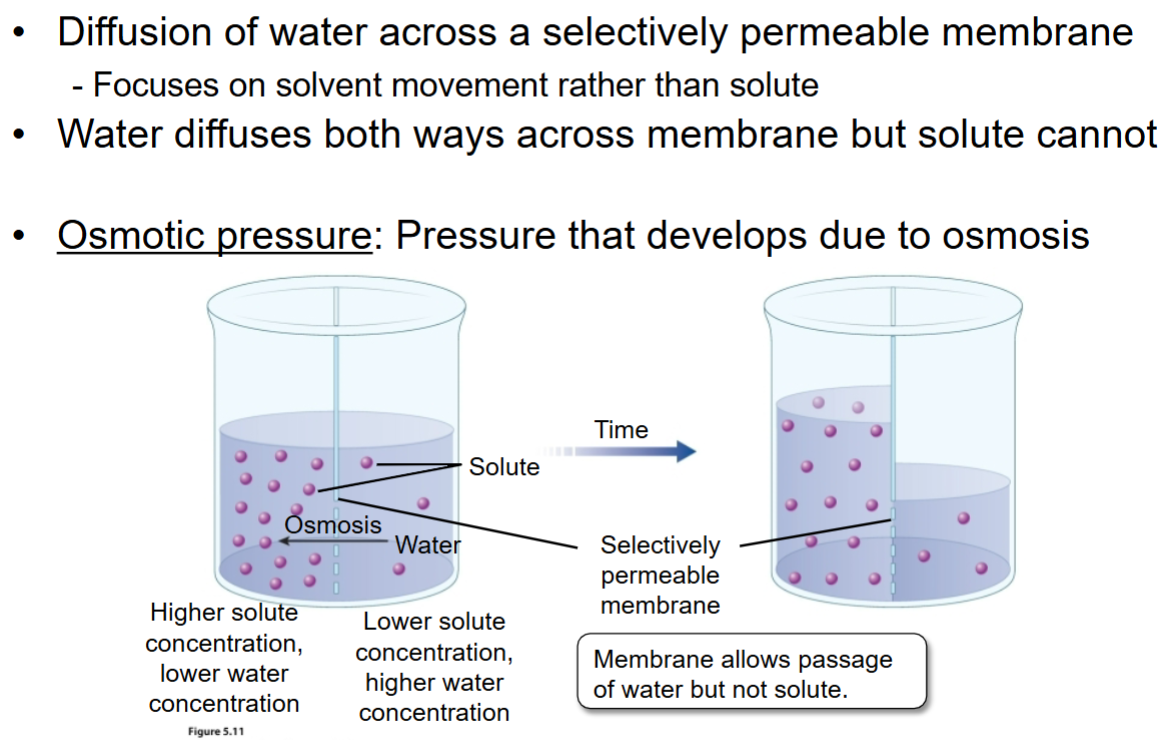
What happens to red blood cells in a hypotonic solution?
They swell. If very hypotonic —> leads to lysis (bursting).
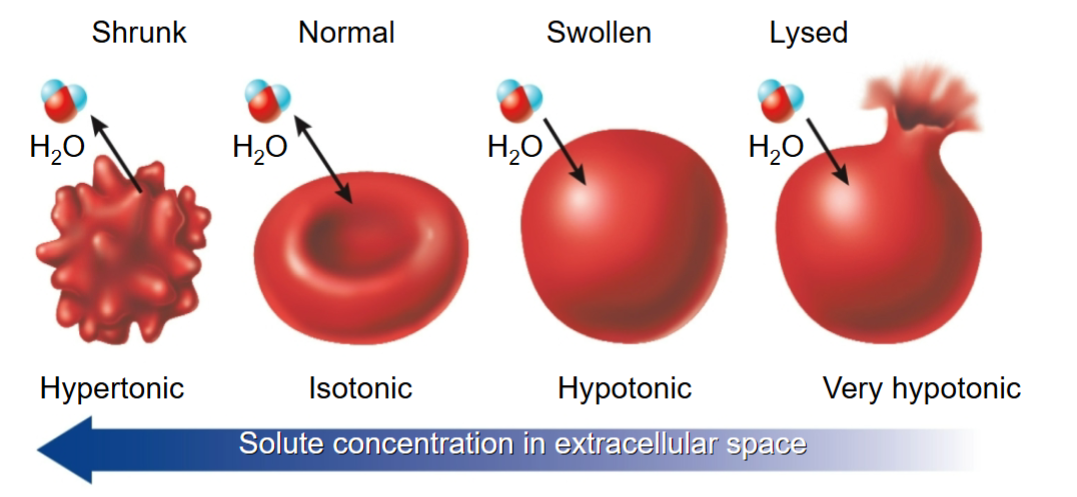
How do red blood cells respond in a hypertonic solution?
They shrink (crenation).
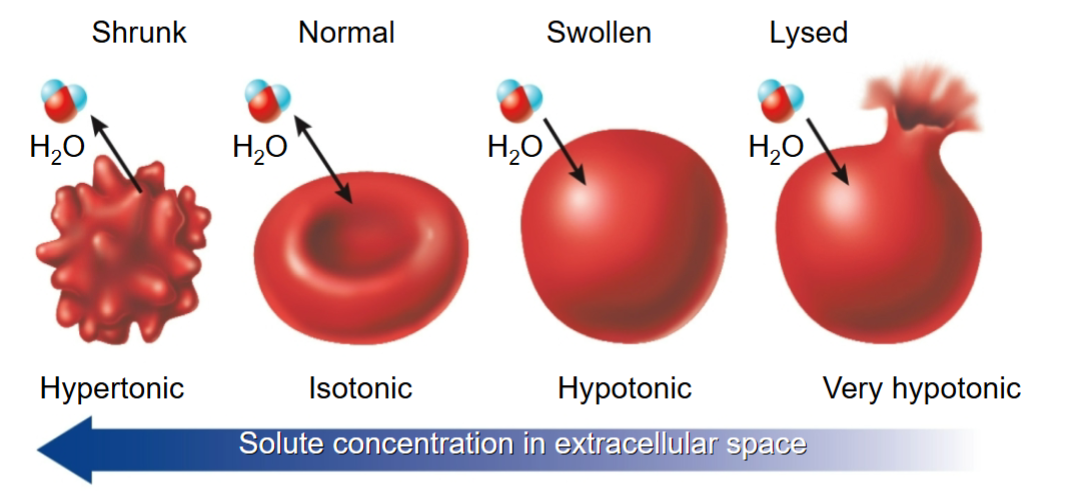
What is facilitated diffusion?
Transport of small molecules using carrier or channel proteins, following concentration gradients without energy.
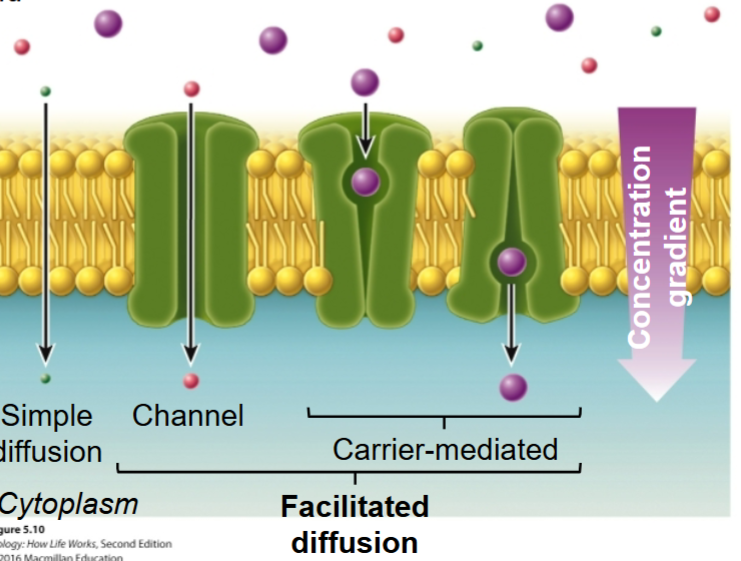
What is the sodium-potassium pump an example of?
Primary active transport, which uses ATP to move substances against their concentration gradients.
What is the role of proton pumps in active transport?
They create a proton gradient that drives secondary active transport mechanisms.
What is exocytosis?
The process of moving materials out of cells through vesicle fusion with the plasma membrane.
What is the primary function of aquaporins?
To facilitate the transport of water across cell membranes. (protein channel for water.)
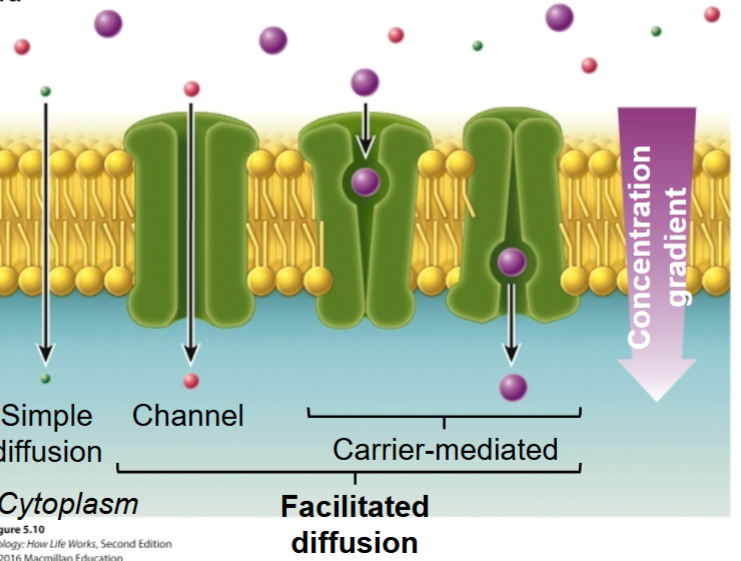
What is the difference between primary and secondary active transport?
Primary uses ATP directly, while secondary uses energy from primary transport without direct ATP use.
What is the significance of dynamic equilibrium in diffusion?
It is reached when net movement stops, but individual molecules continue to move.
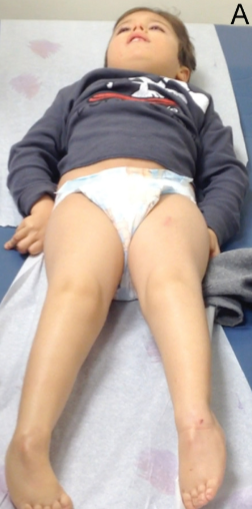
What is the relationship between hereditary spastic paraplegia (HSP) and cell membranes?
HSP is related to disorders affecting the cell membrane, causing leg weakness and spasticity.
High Permeability
Gases such as O₂, CO₂, N₂ and very small uncharged polar molecules like Ethanol.
Moderate Permeability
Small uncharged polar molecules such as Water and Urea.
Low Permeability
Polar organics such as Sugars.
Very Low Permeability
Ions including Na⁺, K⁺, Mg²⁺, Ca²⁺, Cl⁻ and charged polar molecules like Amino acids, ATP, Proteins, nucleic acids, and charged polypeptides.
Advantages of Multicellularity
Specialization (of cells), Size (organism grow big), Complexity (tissues, organ systems), Adaptability (respond better at environment change)
Requirements of Multicellularity
Cell signaling systems (coordinate), Adhesion molecules (for cells --> tissues), Regulate cell division (maintain tissue structure), Apoptosis (removes unnecessary cells), Differentiation mechanisms (for creation of special cell types)
Tissue
A group of cells (similar structure/function.)
Organ
A collection of two or more tissues (that perform specific functions.) (i.e. stomach had muscle and epithelial tissue)
Immunodeficiencies
Impaired immune cell communication. (Pathogens like Vibrio cholerae disrupt normal signaling.)
Cholera toxin
Interferes with G protein signaling, causing severe dehydration through excessive water loss.
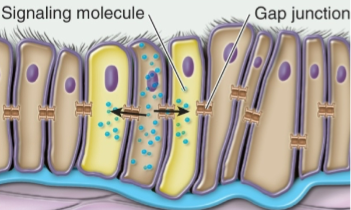
Direct Signaling
Signals pass through a cell junction from the cytosol of one cell to adjacent cells.
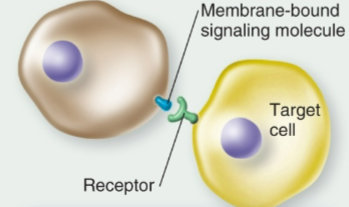
Contact-dependent Signaling
Requires direct cell-to-cell contact.
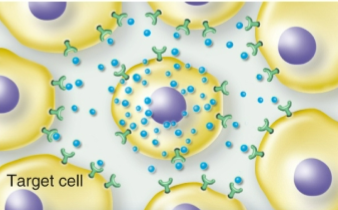
Autocrine Signaling
Cell secretes signals that bind to its own receptors.
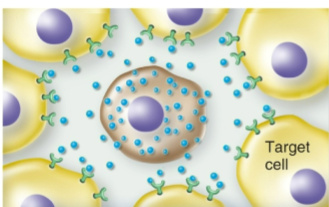
Paracrine Signaling
Short-range signaling between nearby cells.

Endocrine Signaling
Long-distance signaling through hormones. Travels through blood to target organs.
homeostatic control pathway - WHOLE ORGANISM
Stimulus —incoming—> Receptor —interpreting—> Control Center —outgoing—> Effector
Steps in Cell Signaling
Reception (Signal binds receptor at cell surface or intracellular)—>Transduction (Signal converted to cellular response in cytoplasm)—>Response(Cell changes behavior throughout cell)—>Termination (Signal stops (through multiple mechanisms))
Types of Receptors
Intracellular Receptors - Located in cytoplasm or nucleus, bind hydrophobic molecules and activate gene transcription directly.
Cell Surface Receptors -
Ligand-gated ion channels - Open/close ion channels in nerve/muscle cells.
Enzyme-linked receptors - Activate enzymatic activity with extracellular catalytic domains.
G protein-coupled receptors (GPCRs) - Activate G proteins in most cell types.
G Protein Signaling Example: Adrenaline Response (in heart)
In heart cells, Adrenaline binds to GPCRs, activating a cAMP cascade that increases calcium, resulting in a faster, stronger heartbeat.
Signal Amplification
One receptor → many G-proteins → lots of cAMP → multiple PKA targets = big response from a small signal.
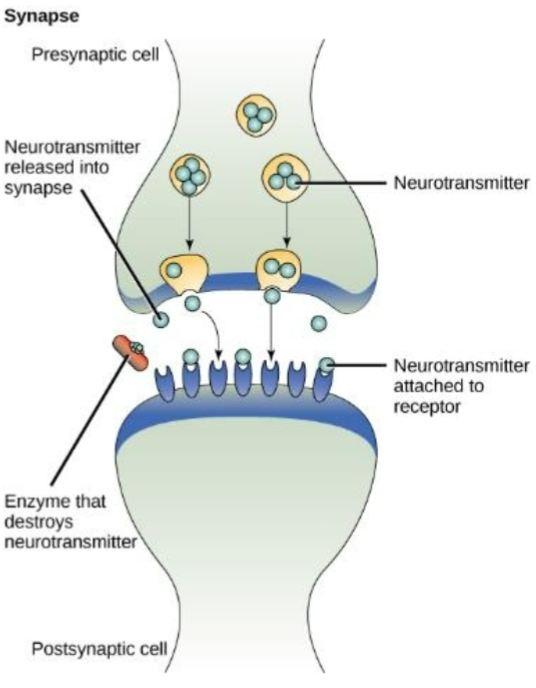
Neurotransmitters use this method across synapses
Paracrine Signaling
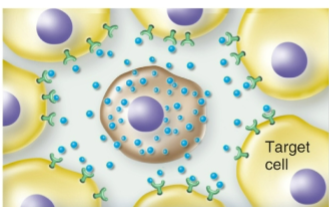
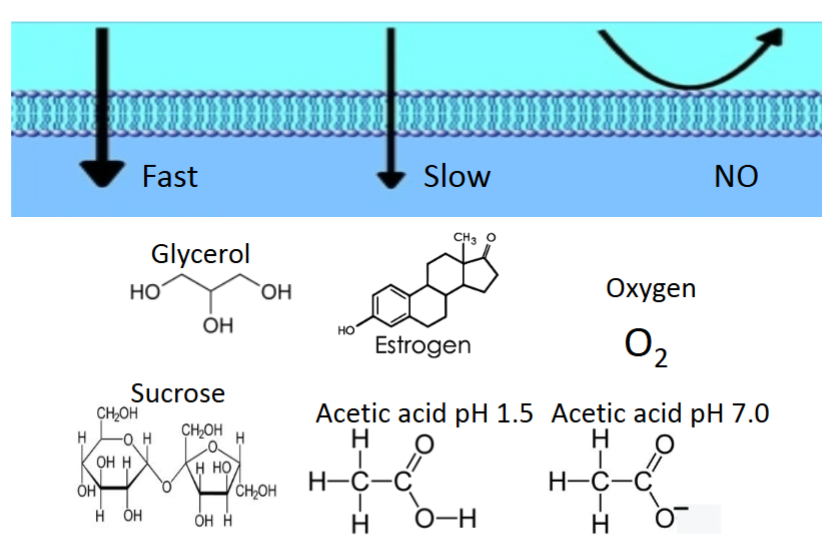
Solve this
estrogen and O2 go through fast. acetic acid pH 1.5 and glycerol go through slow. And sucrose and acetic acid pH 7.0 go through NO.
Example of primary transport
Sodium potassium pump (active transport)
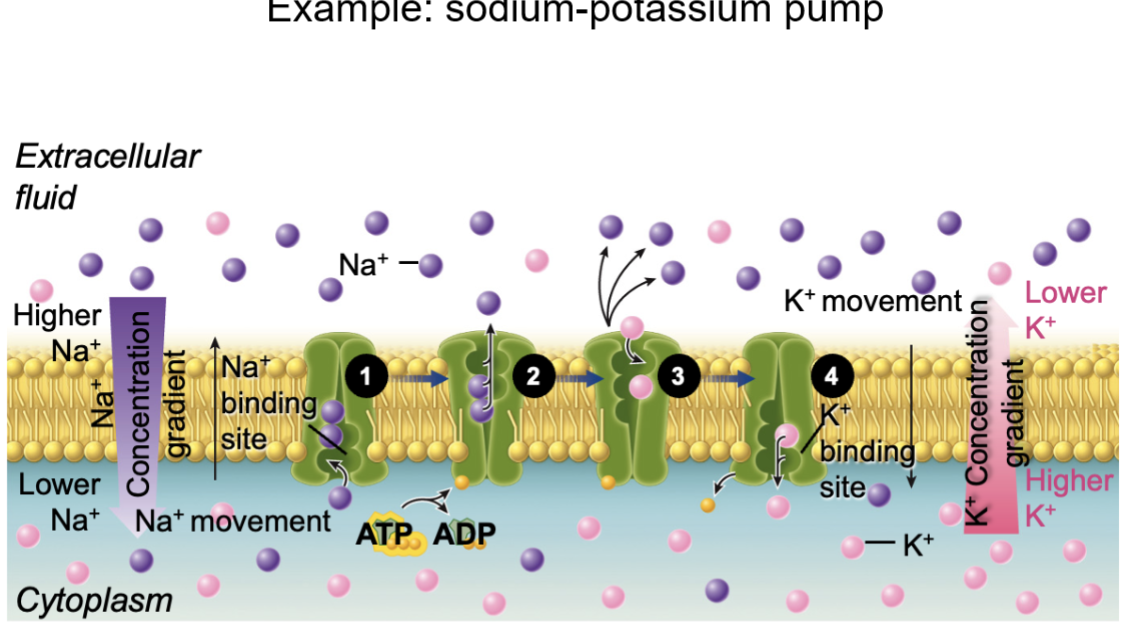
Secondary Transport
(called secondary because it's first step only happens once there's an electrochemical gradient) (different in concentration of a chemical, but also a different in concentration of a charge)
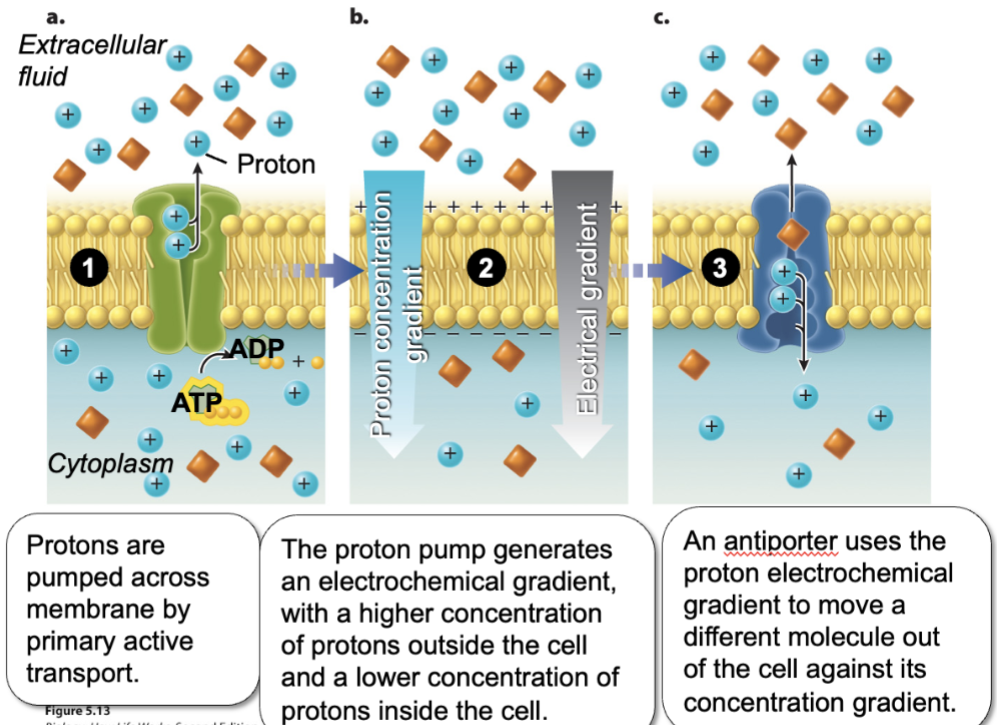
membrane assisted transport
Vesicle is from the golgi apparatus (could be all sorts of things) (digestive enzymes) (hormones) (etc) . And we want them outside the cell. Changes the actually makeup of the membrane. That's why it's called membrane assisted transport.
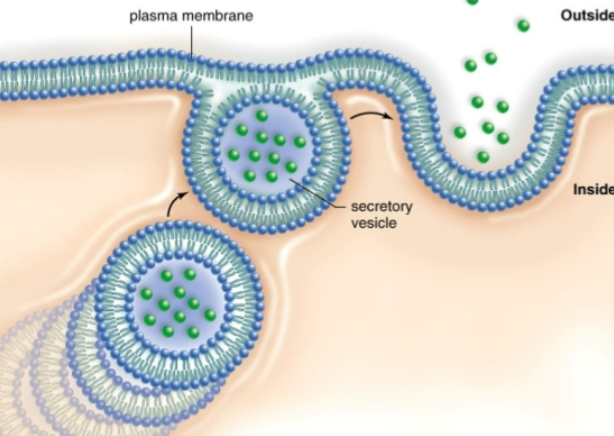
Is the transfer of neurotransmitters an example of exocytosis?
Yes!
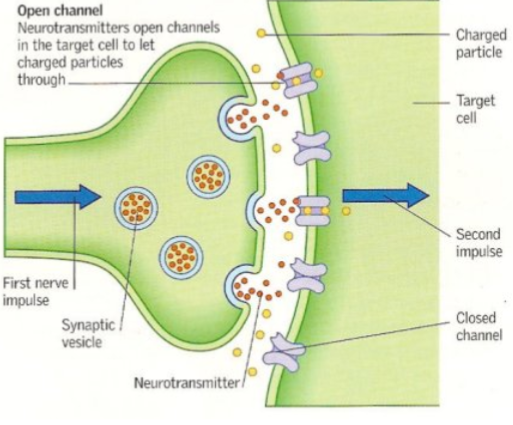
What are the different types of endocytosis?
Phagocytosis (which is shown), pinocytosis, receptor-mediated endocytosis
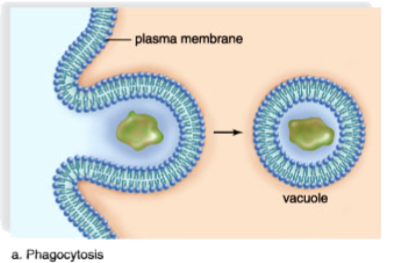
Phagocytosis
“big particles” sometimes called “cell eating”
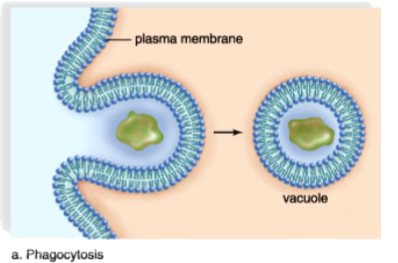
pinocytosis
“fluid” sometimes called “cell drinking”
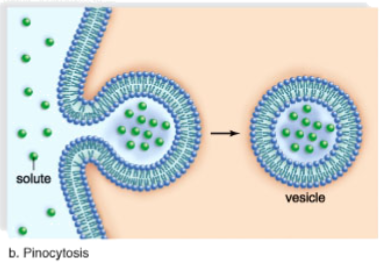
receptor-mediated endocytosis
“specific molecules”
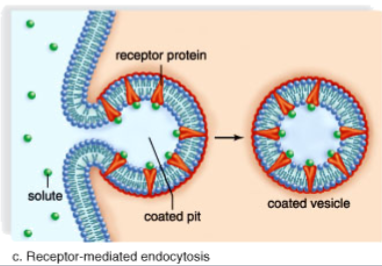
Superfluous - VERY SPECIFIC from other one- Adrenaline activates a signaling cascade:
Adrenaline binds receptor
G protein activates adenylyl cyclase
Adenylyl cyclase converts ATP → cAMP
cAMP activates protein kinase A
Protein kinase A phosphorylates heart proteins
Result: Increased heart rate